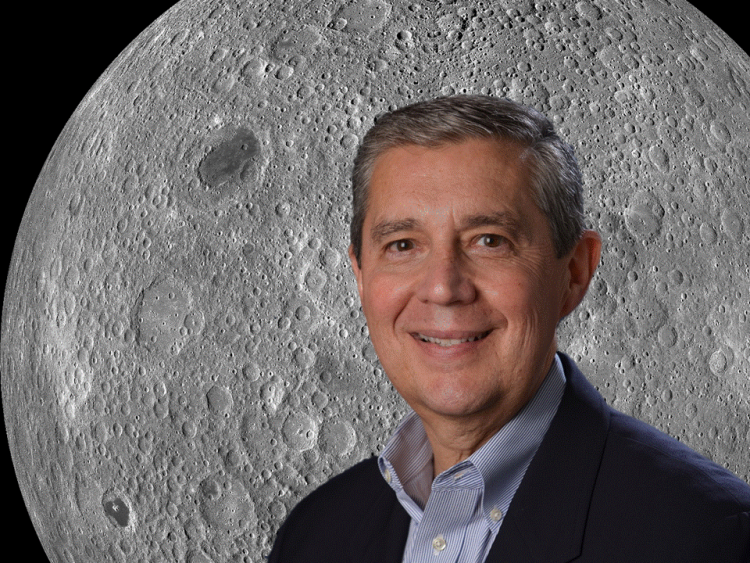Early in the morning Mountain Time today, an Indian lander named Vikram became the first spacecraft to touch down on the surface of the moon near its South Pole. The lander, which carried a six-wheeled rover and is part of the Chandrayaan-3 mission, was a monumental achievement for the Indian Space Research Organisation: India is now just the fourth country to land successfully on the moon.
Just days before, a second lander from Russia didn't fare so well. The Luna-25 spacecraft smashed into the surface of the moon and "ceased to exist," according to a Russian statement-highlighting the fact that getting to the moon is still really hard.
Jack Burns, professor emeritus of astrophysical and planetary sciences at CU Boulder, followed the news of both landers closely. He's a co-investigator on a NASA instrument called Radio wave Observation at the Lunar Surface of the photoElectron Sheath (ROLSES). ROLSES is scheduled to also land on the moon's South Pole later this year aboard a lander dubbed Intuitive Machines-1-part of NASA's ambitious Commercial Lunar Payload Services program.
Burns weighed in on the increasingly international rush to return to the lunar surface, and why, when it comes to the moon, it's important to learn from failures sooner rather than later.

Jack Burns

The Chandrayaan-3 mission launches for the moon in July. (Credit: Indian Space Research Organisation)
In the Apollo era, the space race was between two global powers: the U.S. and Soviet Union. How has it become so much more international today?
The interest in the moon today is driven by the fact that it's now accessible for the first time, really ever. In the 1960s and 70s, it took all of the resources of the wealthiest nation in the world, the United States, to just get to the moon and land. Today, with 50 years of advancement in technology, it's now much less expensive so that individual companies, as well as countries, can afford to go to the moon.
For some of those entities, the moon also isn't the final destination. How might the moon help us go even farther-to Mars, say, or even beyond?
Our moon is the biggest moon relative to the size of its planet in the solar system. That's really fortunate because it allows us to learn how to explore and even live in an alien, hostile environment-in other words, to develop our space legs so we can go out and explore. The moon is the first step to becoming a permanent spacefaring civilization.
Russia's failed landing attempt, however, shows that getting to the moon still isn't easy. How is the U.S. addressing these challenges?
Space in general is hard. Just getting into Earth orbit is still challenging, although much, much easier than it was 50 years ago.
NASA, through its Commercial Lunar Payload Services program, is now paying individual companies to bring scientific payloads to the surface of the moon. The companies build the lander. They get us there.
This program will help the companies understand the challenges of landing on the moon. In some cases, that means learning through failure.
What's next?
NASA's goal is to return to the moon in the 21st Century, not just with robotic spacecraft but with actual humans.
These uncrewed Commercial Lunar Payload Services missions are a steppingstone toward Artemis. We're learning precision navigation. We're learning precision landing techniques. We're working out all of the bugs in order to get back to the moon.
But this time, we're going to stay there. We're going to make the moon a scientific base of operations, much like Antarctica is a base of operations for science today.
Chandrayaan-3 was the first spacecraft to land near the South Pole. Why do we want to visit these new regions?
With Apollo, we barely scraped the surface of the moon. All those missions were on the near side of the moon, the side facing Earth, and all near the equatorial band. That's all we could do in those days.
But since that time, we've learned that, for example, the South Pole of the moon is rich with water ice. That water ice gives us a resource that will sustain us on the moon-not just for drinking, but also for manufacturing rocket fuel, which we won't have to bring all the way from the Earth.
What about the far side of the moon? China's Chang'e 4 mission landed there in 2019.
The far side is also interesting because it has the oldest and deepest impact basin in the solar system. It dates back to just a few hundred million years after the formation of the Earth-moon system.
We'd like to bring samples back from the far side so we can understand the bombardment history of the moon. That bombardment from asteroids that was happening on the moon was also happening on Earth. It was happening during the early stages in the planet's history that set the stage for life to emerge.
The moon is a history book for us to go in, open those pages and read through them.
Are you excited to go read that history book?
This is really a golden age for space exploration and space science in many ways. We have the tools. We have the instruments and the transportation we didn't have before. And, of course, we have our fingers crossed that we will be able to land successfully on the moon and get some great data.






